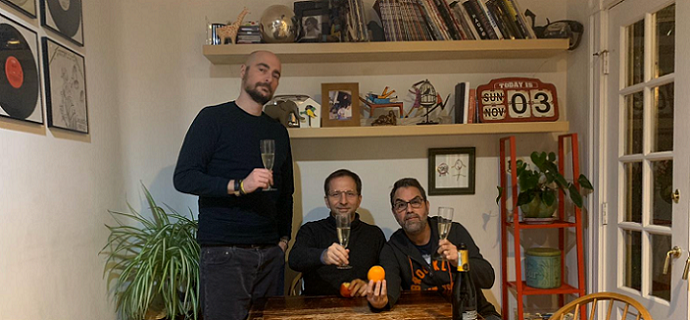

First Comics News: What about writing do you love the most?
Tommaso Todesca: Probably the emotional resonance, that interior loop between writer and reader that can often connect them more than an in-person conversation. Writing for a comic book is particularly stimulating for me because so many people still ignore the limitless potential of the medium. That’s something I want to promote and show to the fullest. And I love the visual challenge in it: the way a silent panel can say more than a thousand words, and the complex art of laying out a page structure.
1st: How did you come to work at Markosia?
Tommaso: I knew Markosia as one of the leading graphic novel publishers in the UK, and when we sent GENU’s manuscript to Harry Markos, its founder, he liked it and contact us back right away, which was a really high point for us through this process. Since then – the end of 2019 – a great working relationship started. Markosia looks for books that are slightly out-of-the-box, and with GENU you can replace the word “slightly” with “waaay”.
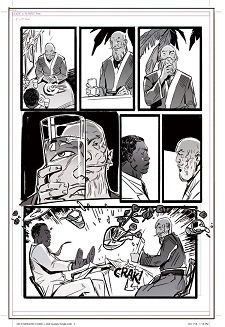
1st: What is original about the story in “Genu”?
Tommaso: In the endless discussions about the plot, as a creative team we had one mantra: “Any idea that smells of trite, banal, or conventional, is going to end up in the bin”. So, writing this book was a challenge, but every one of the 10 chapters of GENU has something original and probably never-seen-before about it. One example above all is the pivotal concept or mystery, that is revealed only toward the end of the story. I won’t spoil it here, but it’s a scientifically plausible theory that we haven’t heard of anywhere else.
1st: Where does the story take place in “Genu”?
Tommaso: The largest portion of GENU’s story takes place in 2125 Tanzania and Sudan. Mercury is also featured as one of the crucial locations.
1st: What genre is “Genu”?
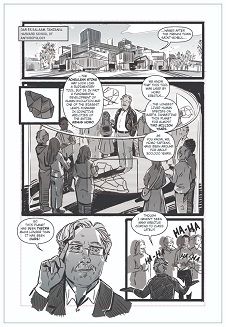
Tommaso: It’s a science-fiction book. I would qualify that by saying that GENU has a literary feel, and that, as a sub-genre, it falls under “hard science-fiction”, a category of science fiction characterized by a special concern for scientific accuracy and logic – both guaranteed by the actual scientist on our team, Giulio.
1st: Where will the story in “Genu” be going in the future?
Tommaso: From the high-octane, dynamic Volume 1 we’ll move into a more detail-rich Volume 2, where we get to know our three protagonists a little better while they gradually come to terms with what has happened to them and understand their new purpose. The main scientific concept around which GENU is structured is introduced in Volume 2. It has to do with a theory that flips modern anthropology on its head.
1st: How does it work to have three writers on the same book?
Tommaso: As a creative team, none of us had any experience of writing together with two other writers. It might sound like a clunky, almost impossible feat, but somehow it came very easy to us. We think it’s because of our long-time friendships, and maybe also because our personalities, in Alex’s words, “are so different from each other that they somehow cover the entire range of possible personalities”. Our three minds tend to work in stunningly complementary ways.
1st: Why should a reader pick up “Genu”?
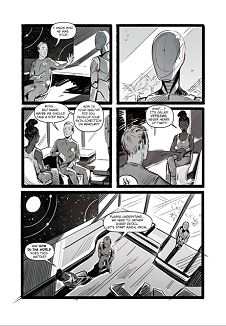
Tommaso: Aside from the fun and entertainment, in GENU a reader will find a lot of hard science to support original ideas, with special technology exposition pages included as an afterword in every volume.
Genu has also quite a strong literary feel, thanks to the themes addressed and to a series of quotes from a fictional book that will be crucial for the plot in many ways.
From the graphic standpoint, we’ve had the blessing to be able to work with Aleksandra Fastovets, whose art is incredibly expressive – especially in the greyscale – and will have readers’ eyes go back to some pages over and over just for the visual pleasure of it.
1st: Can you tell us what your graphic novel “Science and Faith” is about?
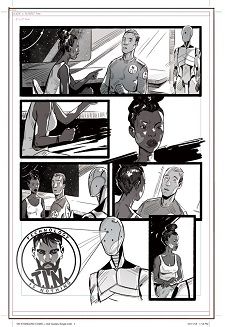
Tommaso: “Science and Faith” is such a different work from GENU: it’s the graphic novel adaptation of a non-fiction book written by two Italian professors. By referencing philosophers, theologians and scientists, both ancient and modern, the book examines the relationship between science and faith (coming from an Italian point of view, the catholic faith) and tries to shed some light on this topic in a light-hearted and visually appealing way. “Science and faith” received many positive reviews, and it has a special meaning for me. I’m currently working with an Italian publisher on the Italian edition, that, COVID permitting, should come out around the end of 2020.
1st: Do you have any ideas for other comic books?
Tommaso: Yes, many. In fact, 86 of them. And I wish this was a made-up number!
For our next project, the three of us have been toying with a strong concept for a horror graphic novel. But no final decision yet.
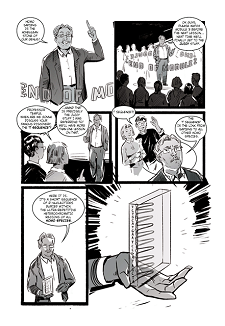
1st: Do you have a certain place where you do your writing?
Tommaso: In the evening, at my living room table. In the weekend, at home or at a coffee place.
1st: Where does your inspiration come from?
Tommaso: Nothing is excluded. Even a budgeting spreadsheet or a documentary about peacocks can provide the spark for an exciting project or for a specific detail. I’ve always been an eclectic reader who likes to jump from fiction to history books, from economy to current affairs to the great classics. I don’t love comic books more than any other type of books.
 1st: What other comic books besides your own would you recommend?
1st: What other comic books besides your own would you recommend?
Tommaso: I tend to prefer graphic novels to issue-by-issue comics. My list of favorites includes Asterios Polyp by Mazzucchelli, The Photographer by Lefevre and Guibert, Maggy Garrisson by Lewis Trondheim, and The Savage Shores by Ram V. White Death by Morrison and Adlard, about WWI in the Italian Alps, is also an unmissable gem.
1st: Any last words for anyone who enjoys “Genu”?
Tommaso: Yes – look carefully for hidden references and clues. There are a ton of them, and I hope they will make the book even more interesting and fun to read.
